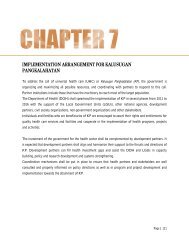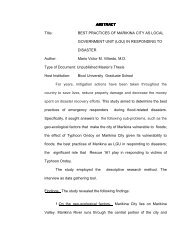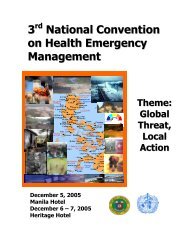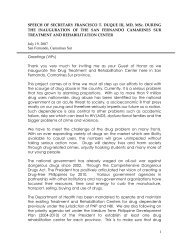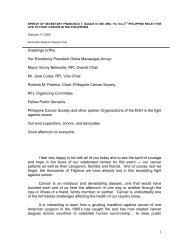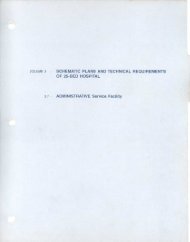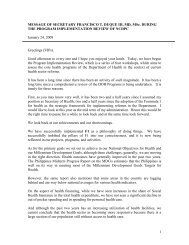Issue No. 69 - March - April 2012 - DOH
Issue No. 69 - March - April 2012 - DOH
Issue No. 69 - March - April 2012 - DOH
- No tags were found...
You also want an ePaper? Increase the reach of your titles
YUMPU automatically turns print PDFs into web optimized ePapers that Google loves.
Call for Tobacco-Free MoviesThe 37th Annual MMFF isspearheaded by the Metropolitan ManilaDevelopment Authority (MMDA) – theoverseer of Metro Manila, the Philippines’premiere region, which hosts 14 millionresidents and consists of 16 cities and amunicipality. MMDA is led by ChairmanFrancis N. Tolentino, whose current“Enforcement of Smoke Free Policy” programregulated the use and consumption oftobacco products in confined public places.In retaliation to his exemplary advocacy, thetobacco industry challenged the authority ofhis office, criticized him harshly in the media,and filed administrative suits against him.Tolentino did not waver in his cause and hecontinued his advocacy even in the holdingof the MMFF.On June 2, 2011 when Tolentinoannounced the extension of the submissionof scripts in order to qualify as MMFF entries,he also called on participating movieproducers to exclude scenes that show actorssmoking cigarettes. He said such scenes infilms entice people to crave for a cigaretteand that young viewers alike are enticed tosmoke as they are indirectly being told thatsmoking is cool when they see a popularactor puffing a cigarette. He said, “We don’twant to send the wrong message to ourchildren. We want to inculcate positive,health-conscious values and awareness.”The Philippines Global YouthTobacco Survey (2007), a school-basedsurvey of students 13-15 years old, showedthat 27.4 per cent of youth (34.7% males,19.6% females) currently smoke cigarettes.And despite the ban on tobacco advertisingin Philippine mass media, as high as 88%saw pro-cigarette ads on billboards and84.7% saw pro-cigarette ads in newspapersand magazines.Movie folk expressed alarm andcommented that Tolentino’s appeal ordirective is an encroachment on artisticfreedom. In general, they say that filmmakingis built on the nuances of characterizationand if smoking will project the nature ofa role or enhance cinematography, it isjustified. If the actor’s character is smoking,it does not mean he is setting a bad exampleto the youth. Even in animé, there arecharacters who are smoking. Children watchthis and they know how to distinguish reeland real life.Counting Smoking in MMFF MoviesThe result of Tolentino’s appealfor tobacco-free movies seemed to betried, ridiculed and rejected by more thanhalf of the producers participating in the37th MMFF. A Department of Health studyentitled “Tobacco-Free Movies: Is It Possiblein the Metro Manila Film Festival?” countedthe scenes, shots and seconds smoking thatwere shown in each of the seven (7) officialMMFF entries, analyzed the context inwhich smoking was used, and determined iftobacco brands were identified in the movie.The latter would constitute a violation underRepublic Act 9211 (Tobacco Regulation Actof 2003) that prohibits tobacco advertisingin mass media.The monitoring of movies wasdone in cinemas during the Film Festivalperiod. At first viewing, the total number ofrunning time, scenes and smoking sceneswere counted. When smoking scenes werepresent in a film, a second or third viewingwas necessary to count the total numberof shots and seconds. The actual countingof scenes, shots and seconds was donemanually and this becomes the limitation ofthe study. Accuracy was estimated at plus orminus 10 scenes, shots and seconds.A scene is one of the basic structuralunits of the film taken at one basic time andplace. A scene is composed of several shots.A shot is a photographic view or exposureand in the study tried to differentiate thesmoking exposure into: long shot (full viewof object or human figure some relation toits surroundings); medium shot (a shot ofthe person from the knees up or the waistup); and close-up (a shot of a person fromthe shoulders up). This was done to analyzehow the film showed detail, character, andintricate emotion to the act of smoking. Themore medium and close-up shots used, themore importance is given to the message ofsmoking.Although there are severalstudies of this kind in other countries, thisis a pioneering study in the Philippines, atobacco-growing country that has bannedtobacco advertising in mass media but stillhas strong tobacco industry influence inpolitics, governance, culture and the arts.The results provide a brief snapshot to helpunderstand how smoking is portrayed inPhilippine movies.Smoking-Filled Movie LeadsSeven entries were included in theroster of films to the 37th MMFF. Originally,11 films submitted the required scripts tothe Festival. Only eight films were chosenas official entries. However, due to someproduction issues, two films pulled out ofthe competition. One spot was filled in bythe ninth movie that was earlier not includedin the official list.This movie is the “ManilaKingpin: The Untold Story of AsiongSalonga,” a black-and-white, biography,gangster, action flick starring Jorge Estregan(a.k.a. ER Ejercito) and produced by VIVACommunications Inc. and Scenema ConceptInternational. It was originally directed byTikoy Aguiluz, but he secured a court orderto have his name removed from the credits26 HEALTHbeat I <strong>March</strong> - <strong>April</strong> <strong>2012</strong>



